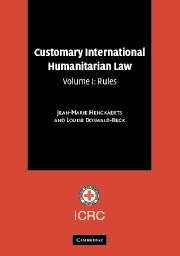Book contents
- Frontmatter
- Contents
- Foreword by ICRC President Jakob Kellenberger
- Foreword by Judge Abdul G. Koroma
- Foreword by Yves Sandoz
- Acknowledgements
- Introduction
- List of abbreviations
- Part I The Principle of Distinction
- Chapter 1 Distinction between Civilians and Combatants (Rules 1–6)
- Chapter 2 Distinction between Civilian Objects and Military Objectives (Rules 7–10)
- Chapter 3 Indiscriminate Attacks (Rules 11–13)
- Chapter 4 Proportionality in Attack (Rule 14)
- Chapter 5 Precautions in Attack (Rules 15–21)
- Chapter 6 Precautions against the Effects of Attacks (Rules 22–24)
- Part II Specifically Protected Persons and Objects
- Part III Specific Methods of Warfare
- Part IV Weapons
- Part V Treatment of Civilians and Persons Hors De Combat
- Part VI Implementation
Chapter 5 - Precautions in Attack (Rules 15–21)
Published online by Cambridge University Press: 05 June 2012
- Frontmatter
- Contents
- Foreword by ICRC President Jakob Kellenberger
- Foreword by Judge Abdul G. Koroma
- Foreword by Yves Sandoz
- Acknowledgements
- Introduction
- List of abbreviations
- Part I The Principle of Distinction
- Chapter 1 Distinction between Civilians and Combatants (Rules 1–6)
- Chapter 2 Distinction between Civilian Objects and Military Objectives (Rules 7–10)
- Chapter 3 Indiscriminate Attacks (Rules 11–13)
- Chapter 4 Proportionality in Attack (Rule 14)
- Chapter 5 Precautions in Attack (Rules 15–21)
- Chapter 6 Precautions against the Effects of Attacks (Rules 22–24)
- Part II Specifically Protected Persons and Objects
- Part III Specific Methods of Warfare
- Part IV Weapons
- Part V Treatment of Civilians and Persons Hors De Combat
- Part VI Implementation
Summary
Rule 15. In the conduct of military operations, constant care must be taken to spare the civilian population, civilians and civilian objects. All feasible precautions must be taken to avoid, and in any event to minimise, incidental loss of civilian life, injury to civilians and damage to civilian objects.
Practice
Volume II, Chapter 5, Section A.
Summary
State practice establishes this rule as a norm of customary international law applicable in both international and non-international armed conflicts. The two components of this rule are interrelated and the practice pertaining to each reinforces the validity of the other. This is a basic rule to which more content is given by the specific obligations contained in Rules 16–21. The practice collected in terms of those specific obligations is also relevant to prove the existence of this rule and vice versa.
International armed conflicts
The principle of precautions in attack was first set out in Article 2(3) of the 1907 Hague Convention (IX), which provides that if for military reasons immediate action against naval or military objectives located within an undefended town or port is necessary, and no delay can be allowed the enemy, the commander of a naval force “shall take all due measures in order that the town may suffer as little harm as possible”. It is now more clearly codified in Article 57(1) of Additional Protocol I, to which no reservations have been made.
- Type
- Chapter
- Information
- Customary International Humanitarian Law , pp. 51 - 67Publisher: Cambridge University PressPrint publication year: 2005
- 3
- Cited by

